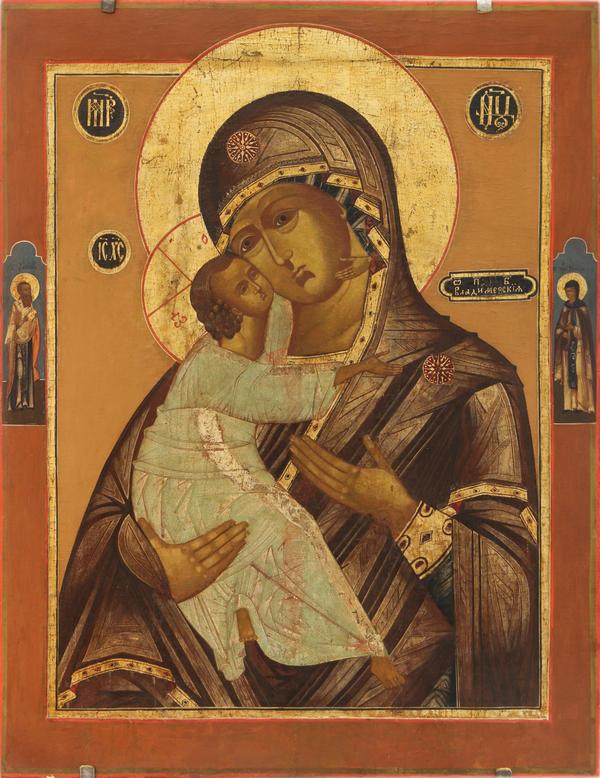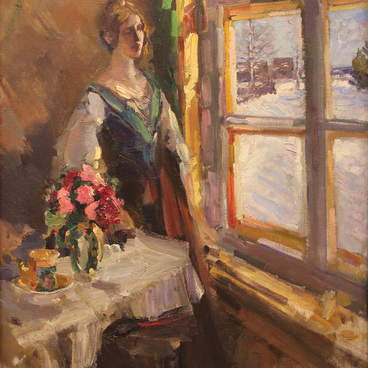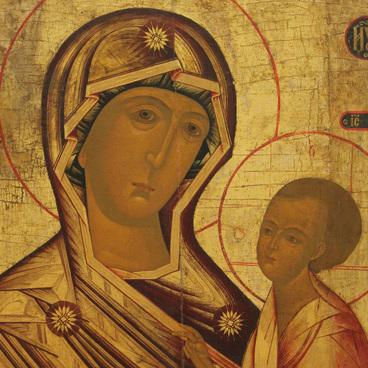The Vladimir icon of the Virgin Eleousa with Saints in the frame from the collection of the Khanty-Mansiysk State Museum of Fine Arts was painted by an unknown artist in the second half of the 19th century. The Virgin Eleousa, or Tenderness, is one of the most popular iconographic types in the Russian icon painting. It shows the Mother of God pressing her cheek against the cheek of her Child, symbolizing the infinite maternal love and the future sacrifice of Christ on the Cross as an expression of God’s love for the people.
The icon from the museum collection follows the type of the Vladimir icon of the Virgin of the late 11th - early 12th century brought from Constantinople around 1130. In the middle of the 12th century Prince Andrei Bogoliubskiy brought that icon from Kievan Vyshgorod to Vladimir. In 1480, the Vladimir icon was transferred to the Dormition Cathedral in Moscow, and today it is held in the Tretyakov Gallery.
The master depicted the Mother of God waist-deep, with the Child Christ sitting on her right arm. With his left hand he touches his mother’s face, his right hand outstretched. The Child’s left leg is bent showing the sole of his foot – the baby’s heel. From the 15th century on, the little heel became an obligatory attribute of the Virgin of Vladimir’s iconography.
The Theotokos is wearing a reddish-purple mantle, maphorion. It is traditionally decorated with gold stars signifying Mary’s virginity before the birth of Jesus Christ, during and after it. The painter emphasized the maphorion’s folds with broad golden bands, and its border and cuffs are decorated with stones and pearls. St. Mary’s and the Child’s halos are gold, traced with red and white outlines. On both sides of their heads there are dark green medallions with inscriptions, or titles.
The Khanty-Mansiysk’s variant of the Vladimir icon is supplemented with the full-size figures of Saint Basil the Great, the bishop of Caesarea, and Xenia the Righteous, inside ornate frames against a dark blue background. Saint Basil is holding a closed book of Gospel. He is wearing a dark green surplice and a light pink, with golden folds, phaelonion, the cloak that Orthodox priests put on for the liturgy. There is a broad white band with thin black crosses, an omophorion, painted by the master over the phelonion. Saint Xenia the Righteous is depicted in a koukoulion, a nun’s headdress. She is wearing a loose-fitting light-brown chiton, a mantle and a paraman - a square kerchief depicting the instruments of the Crucifixion. Scholars believe the saints could have been namesakes of the people who ordered the icon to be painted.
The icon from the museum collection follows the type of the Vladimir icon of the Virgin of the late 11th - early 12th century brought from Constantinople around 1130. In the middle of the 12th century Prince Andrei Bogoliubskiy brought that icon from Kievan Vyshgorod to Vladimir. In 1480, the Vladimir icon was transferred to the Dormition Cathedral in Moscow, and today it is held in the Tretyakov Gallery.
The master depicted the Mother of God waist-deep, with the Child Christ sitting on her right arm. With his left hand he touches his mother’s face, his right hand outstretched. The Child’s left leg is bent showing the sole of his foot – the baby’s heel. From the 15th century on, the little heel became an obligatory attribute of the Virgin of Vladimir’s iconography.
The Theotokos is wearing a reddish-purple mantle, maphorion. It is traditionally decorated with gold stars signifying Mary’s virginity before the birth of Jesus Christ, during and after it. The painter emphasized the maphorion’s folds with broad golden bands, and its border and cuffs are decorated with stones and pearls. St. Mary’s and the Child’s halos are gold, traced with red and white outlines. On both sides of their heads there are dark green medallions with inscriptions, or titles.
The Khanty-Mansiysk’s variant of the Vladimir icon is supplemented with the full-size figures of Saint Basil the Great, the bishop of Caesarea, and Xenia the Righteous, inside ornate frames against a dark blue background. Saint Basil is holding a closed book of Gospel. He is wearing a dark green surplice and a light pink, with golden folds, phaelonion, the cloak that Orthodox priests put on for the liturgy. There is a broad white band with thin black crosses, an omophorion, painted by the master over the phelonion. Saint Xenia the Righteous is depicted in a koukoulion, a nun’s headdress. She is wearing a loose-fitting light-brown chiton, a mantle and a paraman - a square kerchief depicting the instruments of the Crucifixion. Scholars believe the saints could have been namesakes of the people who ordered the icon to be painted.



